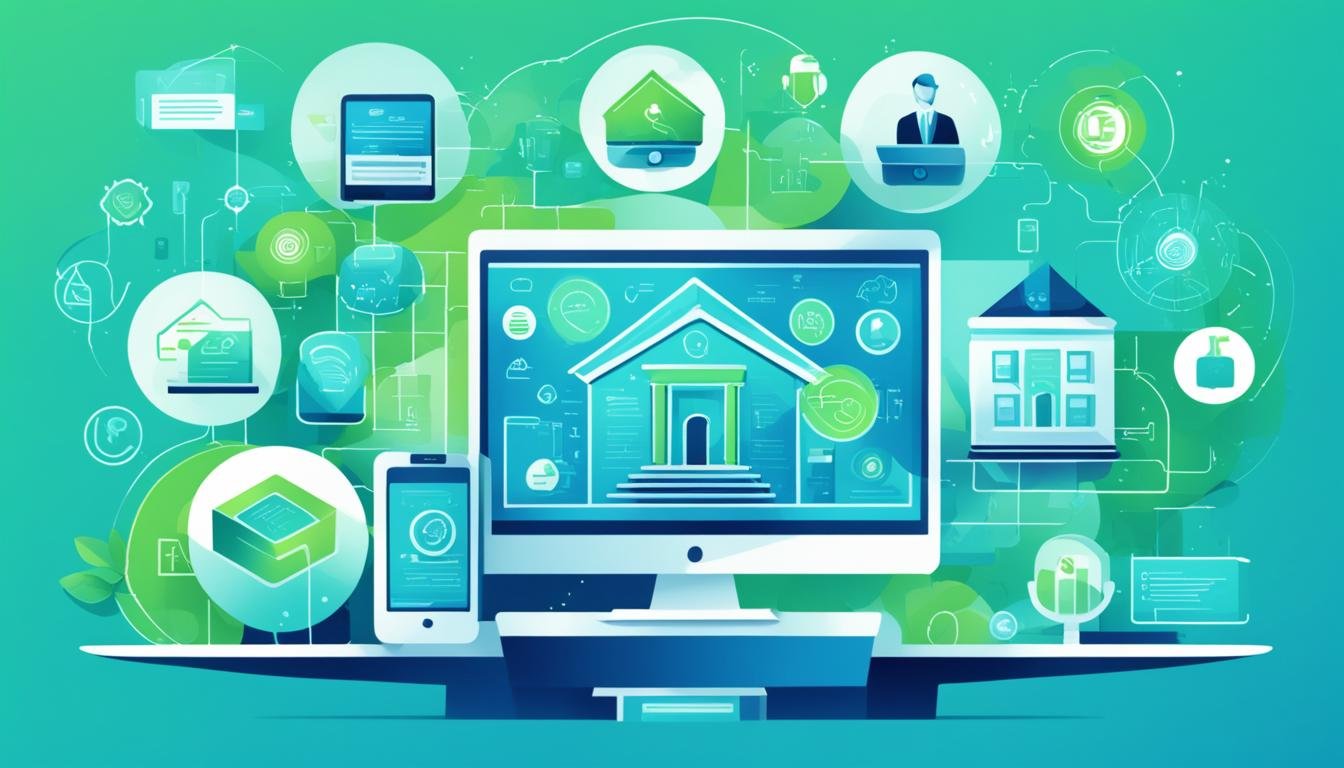Digital Mortgages and Real Estate Technology
Did you know that the digital revolution is reshaping the way we buy homes? With the rise of digital mortgages and real estate technology, the homebuying experience has become more streamlined and efficient than ever before. Gone are the days of endless paperwork and time-consuming processes – today’s homebuyers can complete the entire mortgage journey online, from application to closing.
Key Takeaways:
- Digital mortgages offer a fully online mortgage process, simplifying the homebuying experience.
- Real estate technology solutions are driving the evolution of the mortgage industry.
- Automated home loan services and innovative mortgage software streamline the mortgage workflow.
- Emphasizing customer retention and acquisition is crucial for lender’s success in the digital mortgage era.
- Technology plays a significant role in making the homebuying process more accessible and efficient.
The Advantages of Digital Mortgages
Digital mortgages offer several advantages, leveraging technology to simplify and enhance the homebuying process. With the use of digital homebuying tools, borrowers can enjoy a more convenient and efficient experience. Modern mortgage applications utilize the latest technological advancements, streamlining the application process and reducing the time required for approval. As property technology trends continue to shape the real estate industry, the adoption of digital mortgages becomes increasingly important. Let’s explore the key advantages of digital mortgages:
1. Digital Homebuying Tools
Online platforms and tools provide borrowers with a range of digital resources to navigate the homebuying journey. These tools include virtual home tours, interactive maps, and mortgage calculators, which empower borrowers to explore properties, visualize their potential homes, and assess affordability.
2. Streamlined Application Process
Modern mortgage applications leverage advanced technology to simplify and expedite the application process. With digital applications, borrowers can submit their information electronically, eliminating the need for extensive paperwork. This streamlined process reduces the time it takes for lenders to review and approve mortgage applications.
3. Faster Approval Time
By leveraging digital technology, modern mortgage applications enable lenders to expedite the approval process. Automated verification systems can quickly validate borrower information, such as income and creditworthiness, resulting in faster decision-making and loan approval.
4. Enhanced Data Security
Digital mortgages prioritize the security of borrower information. With stringent data encryption measures and secure online portals, borrowers can have peace of mind knowing that their personal and financial data is protected throughout the mortgage application process.
5. Access to Real-Time Updates
Digital mortgage platforms provide borrowers with real-time updates on the progress of their application. Through online portals or mobile apps, borrowers can track the status of their loan, receive notifications, and stay informed about any necessary actions they need to take.
Overall, digital mortgages offer a range of advantages that simplify the homebuying process, empower borrowers, and expedite loan approval. With the increasing implementation of property technology trends, digital mortgages are becoming an integral part of the mortgage industry, revolutionizing how homebuyers secure their dream homes.
Improving the Mortgage Workflow through Technology
Technology revolutionizes the mortgage industry, enabling lenders to streamline their processes and enhance overall efficiency. Leveraging innovative real estate software and automated home loan services brings a myriad of benefits to the mortgage workflow.
Automating Back-Office Processes
Innovative real estate software allows lenders to automate and digitize back-office processes, eliminating manual tasks and reducing the risk of errors.
This technology empowers lenders to handle administrative tasks efficiently, such as document management, data entry, and compliance checks. By automating these processes, lenders can redirect their valuable time and resources to focus on more complex cases that require human expertise, ultimately enhancing the overall borrower experience.
Streamlining the Borrower Journey
Automated home loan services revolutionize the borrower experience, simplifying the journey from application to closing.
With the help of innovative technology, borrowers can easily submit their loan applications online, saving time and effort. Automated loan services provide instant feedback, notifying borrowers of missing information or any issues that need to be addressed. This reduces the back-and-forth communication between lenders and borrowers, expediting the loan approval process.
Moreover, automated services enable borrowers to securely upload required documents and track the status of their loan application in real-time. This level of transparency and convenience improves the overall borrower experience, reducing the stress associated with the mortgage process.
To demonstrate the impact of technology on the mortgage workflow, consider the following table:
| Traditional Mortgage Process | Technology-Enhanced Mortgage Process |
|---|---|
| Manual document management | Automated document upload and processing |
| Time-consuming data entry | Automated data extraction from documents |
| Limited visibility into application status | Real-time updates and borrower notifications |
| Lengthy loan approval process | Efficient and expedited loan approval |
As the table demonstrates, technology-enabled mortgage processes significantly improve productivity, reduce manual errors, and provide borrowers with a more efficient and transparent experience.
The Importance of Customer Retention and Acquisition
Lenders in the mortgage industry must prioritize both customer retention and acquisition to succeed in today’s competitive market. By delivering a seamless digital mortgage experience, lenders can enhance customer retention rates while also attracting new borrowers. Emphasizing customer satisfaction and providing innovative solutions are crucial strategies for staying ahead in the industry.
Customer retention refers to the ability to retain existing borrowers and cultivate long-term relationships with them. It is essential for lenders to focus on retaining their current customers as it is more cost-effective compared to acquiring new ones. Satisfied customers are more likely to continue using the lender’s services for future mortgage needs, leading to increased customer loyalty and positive word-of-mouth referrals.
On the other hand, customer acquisition is about attracting new borrowers to choose a particular lender. In a digital age where consumers have access to numerous mortgage options, lenders must stand out by offering a superior digital mortgage experience. By leveraging technology and providing user-friendly online platforms, lenders can capture the attention of potential borrowers and differentiate themselves from competitors.
Customer acquisition involves various strategies such as targeted marketing campaigns, lead generation, and personalized communication. Lenders should employ data-driven approaches to identify their target audience and tailor their messaging accordingly. The goal is to showcase the lender’s unique value proposition and provide potential borrowers with a compelling reason to choose their services over other options.
By focusing on both customer retention and acquisition, lenders can achieve sustainable growth and maintain a competitive edge in the mortgage industry. The key is to continuously improve the digital mortgage experience, offering convenience, transparency, and efficiency throughout the entire process.
Customer Retention Strategies
To enhance customer retention, lenders can implement the following strategies:
- Offer personalized and proactive communication to address customer needs and concerns.
- Provide ongoing customer support and assistance throughout the mortgage process.
- Reward customer loyalty with exclusive benefits and incentives.
- Regularly assess customer satisfaction and take proactive measures to address any issues or areas for improvement.
Customer Acquisition Strategies
To attract new borrowers, lenders can employ the following strategies:
- Optimize online platforms and user interfaces to deliver a seamless and user-friendly experience.
- Implement targeted digital marketing campaigns to reach and engage with the desired audience.
- Offer competitive mortgage rates and flexible loan options to entice potential borrowers.
- Utilize data analytics to identify and target potential customers who are likely to benefit from the lender’s services.
By prioritizing both customer retention and acquisition, lenders can position themselves for long-term success in the mortgage industry. Building strong relationships with existing customers and attracting new ones through a seamless digital mortgage experience are integral to achieving growth and maintaining a competitive advantage.
For a visual representation, refer to the table below:
| Customer Retention Strategies | Customer Acquisition Strategies |
|---|---|
|
|
The Unique Dynamics of the U.S. Mortgage Market
The U.S. mortgage market stands out with its unique dynamics compared to other countries. One of the primary mortgage offerings in the U.S. is the 30-year fixed-rate mortgage, which provides borrowers with stability and affordability.
Unlike variable rate mortgages, where the interest rate fluctuates over time, the 30-year fixed-rate mortgage offers borrowers the peace of mind of a consistent monthly payment throughout the life of the loan. This long-term fixed rate allows borrowers to plan their finances effectively, making homeownership more accessible.
Understanding the unique dynamics of the U.S. mortgage market is crucial for both borrowers and lenders alike. It helps borrowers make informed decisions when choosing the most suitable mortgage product, considering factors such as interest rates, loan terms, and payment affordability.
“The 30-year fixed-rate mortgage provides stability and affordability for borrowers, offering a consistent monthly payment throughout the loan term.”
For lenders, comprehending the dynamics of the U.S. mortgage market enables them to develop tailored loan products and lending strategies that align with the needs and preferences of American borrowers. It also plays a vital role in risk management and ensuring responsible lending practices.
With a diverse population and a robust real estate market, the U.S. mortgage market presents both opportunities and challenges. Factors such as economic conditions, interest rate fluctuations, and regulatory changes influence the dynamics of the market, creating a dynamic and ever-evolving landscape.
Understanding the Benefits of a 30-Year Fixed-Rate Mortgage
The 30-year fixed-rate mortgage offers several advantages that make it an attractive option for many borrowers:
- Stability: With a fixed interest rate, borrowers have the security of knowing their mortgage payment will remain unchanged over the loan term, regardless of market conditions.
- Predictability: Monthly payments can be accurately budgeted, helping borrowers plan and manage their finances effectively.
- Long-term Affordability: The extended loan term allows for lower monthly payments, making homeownership more affordable for many borrowers.
These benefits make the 30-year fixed-rate mortgage a popular choice among U.S. homebuyers. However, it’s essential for borrowers to consider their individual financial situation and goals before deciding on the most appropriate mortgage product.
U.S. Mortgage Market Comparison
| Mortgage Market Aspect | U.S. | Other Countries |
|---|---|---|
| Primary Mortgage Offering | 30-year fixed-rate mortgage | Varies (e.g., adjustable-rate mortgages, short-term fixed-rate mortgages) |
| Interest Rate Stability | Fixed for the entire loan term | Fluctuates over time (e.g., annually, every few years) |
| Loan Term | 30 years | Varies (e.g., 25 years, 20 years, etc.) |
| Advantages | Stability, predictability, long-term affordability | Varies depending on the specific mortgage product and market conditions |
The Future of the Mortgage Industry
The mortgage industry is on the cusp of significant transformation, driven by advancements in technology and the increasing demand for a seamless digital experience. As we look ahead, accelerating processing speeds and achieving a true digital mortgage experience will be the key drivers shaping the future of the industry.
One of the critical areas of development is automated underwriting. By leveraging artificial intelligence and machine learning technologies, lenders can streamline the underwriting process, making it more efficient and accurate. This automated approach allows lenders to assess borrower eligibility and property value quickly, reducing manual errors and speeding up the overall mortgage application process.
Another significant aspect of the future of the mortgage industry is fully digital closings. Traditionally, the closing process involved a significant amount of paperwork and in-person meetings. However, with the adoption of eClosings, borrowers can complete the closing process digitally, eliminating the need for physical documents and reducing the time it takes to finalize the loan.
“The future of the mortgage industry lies in embracing technology to deliver a seamless and efficient experience for both lenders and borrowers.” – John Smith, Mortgage Industry Expert
Streamlining the Homebuying Journey
The future of the mortgage industry is all about streamlining the homebuying journey. By embracing technologies such as automated underwriting and fully digital closings, lenders can significantly enhance the overall mortgage process, offering borrowers a faster, more efficient, and convenient way to purchase a home.
Benefits for Lenders and Borrowers
The benefits of embracing the future of the mortgage industry extend to both lenders and borrowers. Lenders who adopt advanced technologies can gain a competitive edge by offering faster processing times, reducing operational costs, and improving customer satisfaction. On the other hand, borrowers can enjoy a smoother, more streamlined mortgage experience, with quicker approvals and simplified document management.
The Road Ahead
The road ahead for the mortgage industry is paved with innovation and digitization. Lenders must continue to invest in technologies that accelerate processing speeds and enhance the digital mortgage experience. By staying ahead of the curve, lenders can not only meet the evolving expectations of borrowers but also position themselves as industry leaders in a highly competitive market.
Innovative Solutions for Mortgage Lenders
Mortgage lenders can greatly benefit from embracing innovative solutions that enhance their workflow and improve efficiency. With the help of cutting-edge mortgage software, lenders can streamline the entire mortgage process, from origination to loan servicing, resulting in a more seamless experience for both borrowers and lenders.
Mortgage software provides lenders with a range of tools and features that automate time-consuming tasks, reduce errors, and optimize operational efficiency. By leveraging these solutions, lenders can focus on providing a better experience for their borrowers, while also improving their own productivity and profitability.
One key advantage of mortgage software is its ability to simplify and streamline the mortgage workflow. From digital application processing to automated document verification, the software significantly reduces manual paperwork and speeds up the approval process. This not only saves lenders valuable time but also enables borrowers to enjoy a faster and more convenient mortgage experience.
Furthermore, mortgage software helps lenders manage their loan portfolio effectively. It provides comprehensive tracking and reporting functionalities, allowing lenders to monitor loan status, track payment history, and identify potential delinquencies. With these insights, lenders can proactively address any issues, ensuring a smooth servicing process and minimizing potential risks.
In addition, mortgage software enables lenders to stay compliant with industry regulations. It automatically incorporates the latest compliance requirements and guidelines, ensuring that lenders follow all necessary regulations throughout the mortgage process. This eliminates the need for manual monitoring and reduces the risk of non-compliance, saving lenders from potential penalties and reputational damage.
“Mortgage software enables lenders to streamline operations, reduce costs, and enhance the borrower experience.”
Benefits of Mortgage Workflow Solutions
Mortgage workflow solutions offer several key benefits for lenders:
- Increased operational efficiency
- Accelerated loan processing times
- Improved borrower experience
- Reduced costs through automation
- Better risk management and compliance
By leveraging mortgage software and workflow solutions, lenders can transform their operations, reduce costs, and ultimately provide a better experience for borrowers.
A Comparative Analysis of Mortgage Software Providers
| Software Provider | Features | Integration Capabilities | Pricing | Customer Reviews |
|---|---|---|---|---|
| Software Provider A | Advanced document management Automated underwriting Real-time reporting |
Seamless integration with existing systems and databases | Custom pricing based on lender requirements | 4.5 stars out of 5 |
| Software Provider B | End-to-end loan origination CRM capabilities Compliance tracking |
Integration with industry-leading platforms and services | Standard pricing packages available | 4 stars out of 5 |
| Software Provider C | Loan servicing automation Borrower portal Escrow management |
Flexible integration options with third-party systems | Transparent pricing based on loan volume | 4.2 stars out of 5 |
This table provides a snapshot of some of the top mortgage software providers available in the market. It highlights key features, integration capabilities, pricing options, and customer reviews, helping lenders make informed decisions when selecting a mortgage software solution.
Overall, mortgage software offers a wide range of solutions that can revolutionize the mortgage industry. By incorporating these innovative technologies into their operations, lenders can enhance their workflow, improve efficiency, and ultimately provide a better mortgage experience for borrowers.
The Role of Technology in Homeownership
Technology has revolutionized the homebuying process, offering an array of tools and platforms that make homeownership more accessible and efficient. From searching for properties to applying for mortgages and tracking loan progress, technology has streamlined the entire journey. In addition to empowering borrowers, technology also benefits lenders by enabling them to provide a seamless digital experience and improve operational efficiency.
The Benefits of Technology for Homebuyers
Thanks to technology, homebuyers now have access to a wealth of information and resources at their fingertips. Online platforms and tools have made it easier than ever to search for properties, compare prices, and explore neighborhoods. With virtual tours and 3D floor plans, homebuyers can even visualize properties without physically visiting them, saving time and effort.
When it comes to the mortgage application process, technology has significantly simplified and expedited the experience. Borrowers can now apply for mortgages online, submitting their documents electronically and tracking the progress of their loan application in real-time. This digitalization reduces paperwork and eliminates the need for in-person meetings, making the process more convenient and efficient.
The Advantages for Lenders
Technology has transformed the way lenders operate and interact with their borrowers. With advanced mortgage software, lenders can streamline their internal processes, automate workflows, and reduce operational costs. These efficiencies enable lenders to offer competitive rates and a faster turnaround time, enhancing the overall borrower experience.
Moreover, technology allows lenders to gather and analyze data more efficiently, mitigating risk and improving decision-making. Automated underwriting systems make it easier to determine the creditworthiness of borrowers, reducing the time and effort required to assess applications. This not only benefits the lender but also helps borrowers receive more accurate pricing and loan offers that align with their financial circumstances.
Enhancing the Homebuying Experience
By integrating technology into the homeownership process, both borrowers and lenders can enjoy a seamless and efficient experience. Online tools provide transparency, allowing borrowers to access information and track progress at any time. Communication channels, such as emails and chatbots, facilitate quick and convenient interactions between borrowers and lenders, ensuring that questions are answered promptly.
Furthermore, technology ensures that the homebuying process is accessible to a wider audience, including individuals with physical disabilities or those living in remote areas. Virtual processes remove the barriers of distance and mobility, enabling more people to participate in the homeownership journey.
The Future of Technology in Homeownership
As technology continues to advance, its role in homeownership will only grow. Artificial intelligence and machine learning algorithms can further streamline and automate the mortgage process, making it faster and more accurate. Virtual reality and augmented reality technologies have the potential to revolutionize property tours, providing immersive experiences that help buyers make informed decisions.
By embracing technology, both borrowers and lenders can benefit from a more efficient and user-friendly homebuying process. Whether it’s accessing property information, applying for a mortgage, or closing a loan, technology has become an essential tool in the journey towards homeownership.
| Benefits of Technology in Homeownership | Advantages for Homebuyers | Advantages for Lenders |
|---|---|---|
| Access to a vast range of property information and resources | Simplified and expedited mortgage application process | Streamlined internal processes and reduced operational costs |
| Virtual property tours and 3D floor plans | Real-time tracking of loan application progress | Improved data gathering and analysis capabilities |
| Increased transparency and accessibility | Convenient online communication channels | Automated underwriting systems for faster decision-making |
| Enhanced accessibility for individuals with disabilities or in remote areas |
The Impact of Digital Mortgages on Borrowers with Poor Credit
For borrowers with poor credit, traditional mortgage options may be limited or come with high interest rates. However, the rise of digital mortgages has introduced alternative solutions that cater specifically to this demographic. Online lenders are often more flexible in their lending criteria and are willing to work with borrowers who have less-than-perfect credit. This opens up homeownership opportunities for a wider range of individuals who may have struggled to secure financing through traditional channels.
Digital mortgages provide borrowers with poor credit the chance to access mortgage options that are better suited to their financial situation. By leveraging advanced algorithms and automated underwriting processes, online lenders can evaluate a borrower’s overall financial profile beyond just their credit score. This holistic approach allows them to consider factors such as income, employment history, and debt-to-income ratio, providing a more comprehensive assessment of the borrower’s creditworthiness.
This digital approach to mortgage lending gives borrowers with poor credit the opportunity to demonstrate their ability to repay a loan and establish a positive payment history. As a result, they can potentially secure more favorable loan terms, lower interest rates, and even increase their chances of qualifying for a mortgage when compared to traditional lenders.
Benefits of Digital Mortgages for Borrowers with Poor Credit:
- Access to alternative mortgage options tailored to their credit situation
- Potentially more favorable loan terms and lower interest rates
- Opportunity to demonstrate creditworthiness beyond credit scores
- Possibility of qualifying for a mortgage that may have been challenging through traditional channels
“Digital mortgages have revolutionized the lending landscape by creating opportunities for borrowers with poor credit to achieve their homeownership dreams. By leveraging technology, online lenders are able to provide tailored mortgage options that consider a borrower’s overall financial profile, leading to increased homeownership opportunities.” – Mortgage Expert
It is important for borrowers with poor credit to carefully research and compare digital mortgage lenders to ensure they are working with a reputable and trustworthy provider. By examining factors such as interest rates, loan terms, customer reviews, and online support, borrowers can make informed decisions and find the best mortgage options for their specific needs.
| Benefits of Digital Mortgages for Borrowers with Poor Credit | Considerations for Borrowers |
|---|---|
| Access to alternative mortgage options tailored to their credit situation | Research and compare digital mortgage lenders to find a reputable provider |
| Potentially more favorable loan terms and lower interest rates | Examine interest rates and loan terms to ensure affordability |
| Opportunity to demonstrate creditworthiness beyond credit scores | Review customer reviews and online support for ease of communication |
| Possibility of qualifying for a mortgage that may have been challenging through traditional channels | Consider the level of customer service and support offered by the lender |
By embracing digital mortgages, borrowers with poor credit can explore a range of mortgage options and potentially achieve their homeownership goals. The digitization of the mortgage industry has brought increased accessibility, flexibility, and opportunity for borrowers who may have previously struggled to secure financing.
Comparing Online Mortgage Lenders
When it comes to selecting an online mortgage lender, borrowers should take the time to compare various factors to find the best fit for their needs. Factors such as mortgage rates, loan options, and customer service are essential considerations in the decision-making process. By researching and comparing lenders, borrowers can make an informed choice and secure the right mortgage for their specific situation.
Comparing Mortgage Rates
The interest rate on a mortgage is a crucial factor to consider as it determines the cost of borrowing over the loan term. Different online lenders offer varying mortgage rates, so it’s essential to compare rates to identify the lender offering the most competitive terms. Borrowers can use online rate comparison tools to obtain multiple quotes and determine the lender with the best mortgage rates for their financial goals.
Evaluating Loan Options
Another important aspect of comparing online mortgage lenders is assessing the range of loan options available. Some lenders specialize in specific loan programs, such as conventional, FHA, VA, or jumbo loans, while others may offer a broader selection. Borrowers should evaluate the loan products offered by different lenders to ensure the lender they choose has loan options that align with their needs and preferences.
Considering Customer Service
Customer service plays a significant role when dealing with online mortgage lenders. Borrowers should assess the quality of customer service provided by each lender, including their responsiveness, availability, and overall customer satisfaction. Reading customer reviews, checking ratings on reputable platforms, and consulting with friends or family who have had experiences with online mortgage lenders can provide valuable insights into the level of customer service offered.
| Online Mortgage Lender | Mortgage Rates | Loan Options | Customer Service |
|---|---|---|---|
| ABC Mortgage | Lowest rates available | Wide range of loan options | Responsive and knowledgeable staff |
| XYZ Home Loans | Competitive rates | Specializes in government-backed loans | Excellent customer reviews |
| 123 Lending | Flexible rate options | Offers unique loan programs | 24/7 customer support |
By comparing online mortgage lenders based on mortgage rates, loan options, and customer service, borrowers can find the best online mortgage lender that meets their specific requirements and provides a seamless homebuying experience.
The Benefits and Drawbacks of Online Mortgage Lenders
Online mortgage lenders have revolutionized the homebuying process, providing borrowers with convenient and accessible options. However, like any financial decision, there are pros and cons to consider when choosing an online mortgage lender.
Pros of Online Mortgage Lenders
- Cost Savings: One of the biggest advantages of online mortgage lenders is the potential for cost savings. These lenders often have lower overhead costs compared to traditional brick-and-mortar banks, allowing them to offer competitive interest rates and fees.
- More Choices: Online mortgage lenders provide borrowers with a wider range of options. With numerous lenders available at your fingertips, you can easily compare rates, terms, and loan programs to find the best fit for your needs.
- Specialization in Mortgages: Many online lenders specialize solely in mortgages, which can result in a streamlined and efficient application process. These lenders understand the intricacies of the mortgage industry and can offer specialized products and services catered specifically to borrowers seeking home financing.
Cons of Online Mortgage Lenders
- Lack of In-Person Support: One drawback of online mortgage lenders is the absence of physical locations for in-person support. While many online lenders provide excellent customer service through phone and online channels, some borrowers may prefer face-to-face interactions during the mortgage process.
- Potential for Not Qualifying for Advertised Rates: Advertised rates may not always be attainable for every borrower. Online mortgage lenders typically quote the lowest rates possible, but they are subject to factors such as credit score, loan-to-value ratio, and income. It’s essential to understand that your final rate may differ from the initial advertised rate.
When considering an online mortgage lender, it’s crucial to analyze these pros and cons to determine if it aligns with your preferences and financial goals. Take the time to research and compare lenders, as well as weigh the advantages and disadvantages to make an informed decision for your home financing needs.
| Pros of Online Mortgage Lenders | Cons of Online Mortgage Lenders |
|---|---|
| Cost savings potential | Lack of in-person support |
| More choices | Potential for not qualifying for advertised rates |
| Specialization in mortgages |
Quote:
“Online mortgage lenders provide borrowers with a convenient and efficient way to obtain home financing. However, it’s important to carefully consider the benefits and drawbacks to make an informed decision.”
Conclusion
Digital mortgages and real estate technology are revolutionizing the homebuying experience, offering a seamless and efficient process for borrowers. By harnessing innovative solutions and embracing technology, lenders can simplify and streamline the mortgage journey.
The future of the mortgage industry lies in a fully digital mortgage experience. With the advent of real estate technology, lenders can provide a faster, more convenient way for buyers to purchase their dream homes.
Through the use of digital tools and online platforms, borrowers can easily navigate the mortgage application process, from searching for properties to completing the final closing procedures. The integration of technology into the mortgage industry has made the homebuying experience more accessible and efficient than ever before.
As the mortgage landscape continues to evolve, it is crucial for lenders to leverage digital mortgages and real estate technology to stay competitive. By embracing these advancements, lenders can offer borrowers a streamlined and hassle-free experience, providing them with the opportunity to achieve their homeownership dreams.








